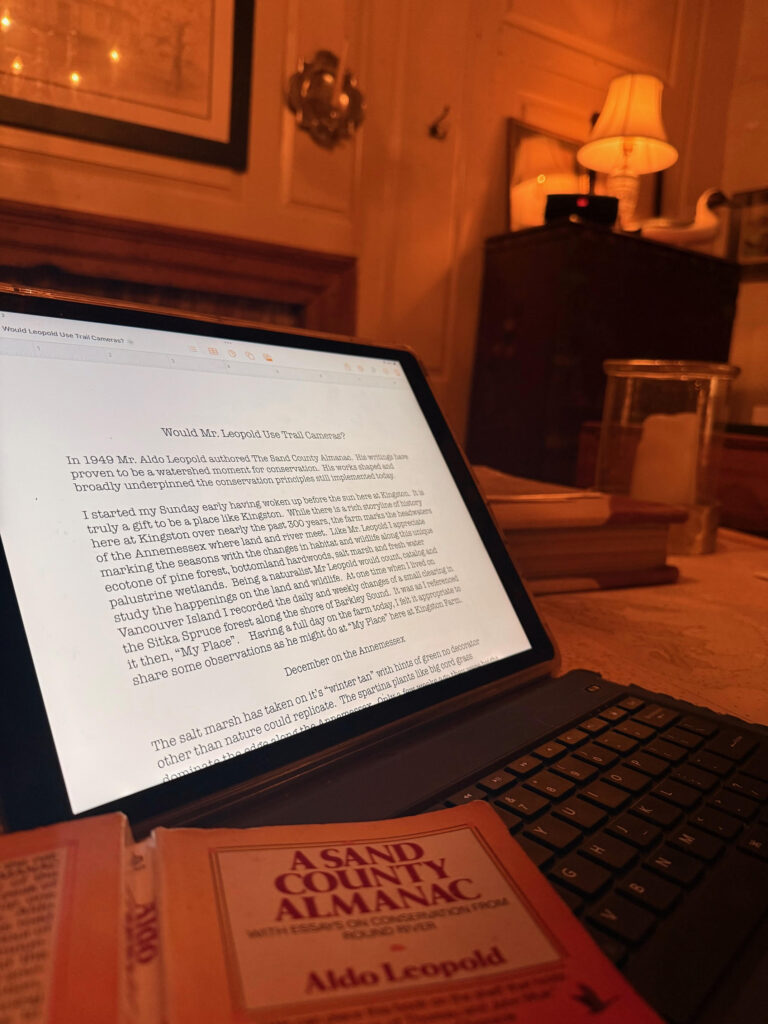Would Leopold Use Trail Cameras?

In 1949, Mr. Aldo Leopold authored The Sand County Almanac. His writings have proven to be a watershed moment for conservation. They shaped and broadly underpinned the conservation principles still implemented today.
I started my Sunday early having awakened before the sun. It is truly a gift to be in this place. While there is a rich storyline of history here at Kingston over the nearly past 300 years, the farm marks the headwaters of the Annemessex where land and river meet. Like Mr. Leopold, I appreciate marking the seasons with the changes in habitat and wildlife along this unique ecotone of pine forest, bottomland hardwoods, salt marsh and fresh water palustrine wetlands. Being a naturalist, Mr. Leopold would count, catalog and study the happenings on the land and wildlife. At one time when I lived on Vancouver Island, I recorded the daily and weekly changes of a small clearing in the Sitka spruce forest along the shore of Barkley Sound. It was, as I referenced it then, “My Place”. Having a full day on the farm today, I felt it appropriate to share some observations as he might do at “My Place” here at Kingston Farm.
December on the Annemessex
The salt marsh has taken on its “winter tan” with hints of green no decorator other than nature could replicate. The spartina plants like big cord grass dominate the edge along the Annemessex. Only a few weeks ago they were bright green and submerged twice daily with each Summer tide. Today, on a Full Moon the eve of the late duck season, the cord grass is a perfect contrast to the rich-dark, nearly black, mud flats along the shore. Together, the influence of the wind and lunar cycle exposes a complex of mud flats yielding the hydrologic energy of the twisting and turning river. The river here at top of the watershed is not broad, but deep in water depth with strong water flow, cutting and carving the land and marsh. If straightened out, this part of the river may take up twice the mileage as it currently does due to its myriad of turns and oxbows. The exposure in the bottom of the river is, however, strategic in that it shares secrets of the river bottom relief, rarely witnessed in the Spring and Summer months, during times of normal tide cycles. These secrets serve as a guide, and one must file this knowledge away for navigating the river when temperatures are warmer, and fishing and boating are the order of the day.
While these mudflats offer a perfect perch for a mallard or blue heron, these environments are not suitable for my boot when setting decoys or chasing a downed duck. I can attest to this fact with much experience. These flats are places a fellow might go and not return. Studying, learning and recording observations such as these days of low tide, Mr. Leopold, one of the original naturalists, would have appreciated.
In Mr. Leopoldo’s Sand County Almanac, he marked December with a chapter titled, “Home Range”. I appreciate this excerpt…
“The wild things that live on my farm are reluctant to tell me, in so many words, how much of my township is included within their daily or nightly beat. I am curious about this, for it gives me the ratio between the size of their universe and the size of mine, and it conveniently begs the much more important question, who is the more thoroughly acquainted with the world in which he lives?”
So there it is, understanding what part of the creek the ducks use, or where the deer trail meanders and where the horned owl is roosting, is clearly the point. We witness wildlife for moments, but beyond the seconds we get to glance, I wonder: Where do they go and how do they know my land better than me? I think clearly that they do, and it is only when we slow down to watch that we learn how wildlife move and utilize habitat. Many years ago, as a young man on the Barkley Sound I learned this. It takes time to study their habits, as they do not move on our schedule or at our pace. We are fortunate when we hear the horned owl at night or find the teal on a bend in the creek not often visited.
Tapping this out today, it makes me think about the way in which we currently track wildlife. Trail cameras have taken much of the discovery of wildlife-watching away from us and simplified it into technology allowing us to be in many places at one time. As Mr. Leopold wrote, “it conveniently begs the much more important question”, would he use trail cameras today?
I have recently questioned this, as we are often obsessed with the knowledge of where the critters are and at what time they move, fly, eat, etc. I wonder what Mr. Leopold would say today about the use of this technology? Are we missing the point or are we cheating ourselves of the full experience? I doubt, for instance, that I would have learned the harbor seal’s habits so well at my place on Barkley Sound had I had two trail cameras on the location. Once the harbor seal got out of the camera’s view, I never would have known from which exact rock he ate his morning catch or enjoyed the morning sun. Nor would I have known from which direction the Harlequin ducks flew in each morning. They would have simply appeared in the frame, just as the wood ducks did this morning on my camera in the flooded timber pond. Today, however, I watched the ducks from a distance confirming whether they traveled up the river to the timber or originated from a different direction.
Knowing this now and after writing this, it certainly and “conveniently begs” the question:
Would Aldo Leopold use trail cameras today?
Be Well,
Ben
